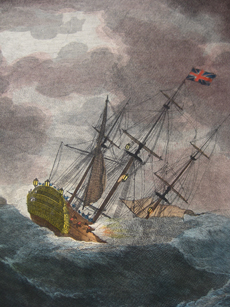History
 The Loss of Victory, 4 October 1744 The Loss of Victory, 4 October 1744by Peter Monamy |
This man of war was constructed at Portsmouth Dockyard by master shipwright Joseph Allin between 1726 and 1737. Victory had a burden of 1,921 tons, a beam of
50ft. 6in. (approx. 15.5m), and a
gun deck 174ft.
One of the most impressive features was her full complement of ordnance, one of the largest consignments of bronze guns ever manufactured. This included 42-pounders, the most powerful and prestigious cannon used in naval warfare. Historically, the Victory marks the final flourish in the life of bronze cannon on English warships. Following the reign of King George I (r. 1714-1727), the Royal Navy phased out their production in favour of cheaper iron guns.
The ship was technically built to be equipped with:
- Lower deck guns: 28 x 42-pounders
- Middle deck guns: 28 x 24-pounders
- Upper deck guns: 28 x 12-pounders
- Quarterdeck guns: 12 x 6-pounders
- Forecastle guns: 4 x 6-pounders
Launched in 1737, the Victory became the flagship of the Channel Fleet under Sir John Norris in 1741, later serving in 1744 under Sir John Balchin, one of the most respected and longest-serving fighting officers in Royal Navy history.
As the War of Austrian Succession waged, the Victory's final voyage began in July 1744, when she was dispatched as the flagship of Admiral Balchin, who had been abruptly called out of retirement to rescue a Mediterranean convoy blockaded in the River Tagus by the notorious Brest fleet of Admiral de Rochambeau. If unsuccessful, England risked losing the war. Accompanied by a large fleet of over 30 ships, Victory arrived in Portugal in late August, liberated the convoy and escorted it safely to Gibraltar. Victory then pursued the retreating French fleet to Cadiz.
During the course of the Victory's voyage back to England, the First Rate warship disappeared with all hands on 5 October 1744. Wreckage marked with the name 'Victory' washed ashore on the islands of Alderney, Guernsey and Jersey. This evidence led to the clear belief that she had been lost off the Casquets, a rocky group of islets northwest of Alderney, an area known as the graveyard of the English Channel.
The shipwreck of the Victory was never found, but Alderney's lighthouse keeper was subjected to a court martial for allegedly failing to keep the lights burning.
After over 250 years of searches conducted by many different expeditions, the shipwreck of the Victory was finally located in 2008, over 100 km from where contemporary reports said she was lost. Odyssey Marine Exploration's discovery of the wreck Victory solved one of the greatest mysteries in maritime history and also exonerated the ship's officers and crew as well as the Alderney lighthouse keeper. Odyssey's archaeological surveys reveal that the Victory likely sank as the result of the violent storm coupled with the ship's top-heavy design, gun-crowded upper decks and possibly rotten timbers.
